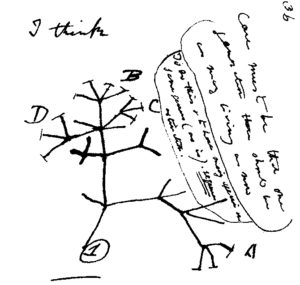 Within just months of returning from a 5-year voyage on the HMS Beagle, Charles Darwin was quick to start working on a new theory in what he called his “notebooks.” The year was 1837. Etched in a leathery notebook with the letter “B” on the cover, now known as Notebook B, with Darwin’s tree diagram. Starting with “1” at the tree trunk, the twigs and branches represent relationships between species, like a family tree. Species were indicated with sequential letters; simple enough.
Within just months of returning from a 5-year voyage on the HMS Beagle, Charles Darwin was quick to start working on a new theory in what he called his “notebooks.” The year was 1837. Etched in a leathery notebook with the letter “B” on the cover, now known as Notebook B, with Darwin’s tree diagram. Starting with “1” at the tree trunk, the twigs and branches represent relationships between species, like a family tree. Species were indicated with sequential letters; simple enough.
Scientists, however, have become increasingly skeptical of Darwin’s tree metaphor to explain how biology works. “Evolution is trickier, far more intricate, than we had realized,” David Quammen explains in his new book entitled The Tangled Tree (2018). Somehow, Darwin’s tree got tangled. What happened?
Notebook B
As a nearly inexhaustible reader and writer, notebooks became Darwin’s workhorses. Notebook A centered on geology. However, starting with Notebook B, his interests turned to his life-long passion – “transmutation.” From 1837 through 1839, Darwin furiously recorded and eventually filled four Notebooks, B, C, D and E, that focus on transmutation along with what he called the “law of adaptation.” Darwin dodged publicly using the term “evolution” until his sixth and final edition of The Origin of Species in 1872. Driven to discover the yet unknown order of biological laws in the wake of the Scientific Revolution, Darwin started documenting a flood-gate of his ideas and observations. Within 3 years, the number of notebook pages exceeded 1,100.
Darwin’s Tree of Life
Darwin’s tree sketch emerged as an enduring metaphor to illustrate the basic framework of his theory. In Notebook B (pictured right) on page 21 Darwin notes –
“Organized beings represent a tree… As many terminal buds dying as new ones generated.”
Originating from the trunk, “each branch separates further into smaller branches,” Darwin explained. Like tree branches originate from a tree trunk, related species originate from a common ancestor. Darwin sketched his now iconic tree, entitled “I Think,” on page 36 of Notebook B as an illustration of his theory: “1” gives rise to the species A, B, C, and D. With “one generation” giving rise to many, Darwin argued, “all animals of [the] same species are bound together just like buds of plants.” Darwin documented what he saw – using the available 19th century technologies. As a consequence, the observations were largely subjective. Importantly, Darwin did not have the technological tools available today to perform objective testing.
Twenty Years Later
“In July [1837],” Darwin explained in his Autobiography, “I opened my first note-book for facts in relation to The Origin of Species about which I had long reflected, and never ceased working for the next twenty years.” 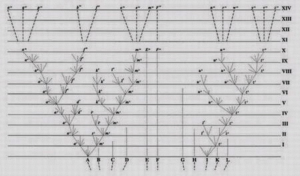 When The Origin of Species was finally published in 1859, his “I Think” tree was updated to a “Diagram” (pictured left) with horizonal lines. The “1” common ancestor in Notebook B – was replaced with eleven between pages 116 and 117. Darwin explained,
When The Origin of Species was finally published in 1859, his “I Think” tree was updated to a “Diagram” (pictured left) with horizonal lines. The “1” common ancestor in Notebook B – was replaced with eleven between pages 116 and 117. Darwin explained,
“When a dotted line reaches one of the horizontal lines… a sufficient amount of variation is supposed to have formed a fairly well-marked variety” – to give rise to a new species.
The horizontal lines were intended to represent epochs of time – starting near the beginning of life. This “Diagram” is the only other diagram or illustration ever published by Darwin. Nor did Darwin never publish a table with data, either. Distinct from the standard format of scientific publications, the use of other diagrams, tables, and charts with testable objective observations or measurements of the evidence were not included in The Origin of Species – or in his other publications.
“Tree of Life” Roots
Darwin was not the inventor of the phrase “tree of life.” The roots of the “tree of life” can be credited to Moses (pictured right) in writing the Genesis account during the 15th century B.C.  Over a period of more than 1,500 years, biblical writers used the phrase 14 times – from Moses writing Genesis; to John writing Revelations. Across the centuries and cultures of human history, the “tree of life” phrase has been widely used as enduring symbol of creation prospering in peace and harmony. Darwin used the phrase as a metaphor for evolution.
Over a period of more than 1,500 years, biblical writers used the phrase 14 times – from Moses writing Genesis; to John writing Revelations. Across the centuries and cultures of human history, the “tree of life” phrase has been widely used as enduring symbol of creation prospering in peace and harmony. Darwin used the phrase as a metaphor for evolution.
Aristotle
 Aristotle, the 4th century B.C. Greek philosopher, is credited as the first to begin systematically ranking species on a “graded scale of perfection” – from simple to complex. Aristotle’s purpose was to understand nature.” Without specifically using the “tree of life” term, his ranking of nearly 500 species was published in his book, the History of Animals. His approach, known as natural philosophy, had a powerful and lasting influence on future generations of naturalists. Even though Aristotle did not include any illustrations, diagrams, tables, or graphs in his book, his system of unifying human knowledge set-the-stage for applying the “tree of life” metaphor to nature. Logic is the instrument, Aristotle argued, to understand and gain knowledge using a what and why approach. Logical schemes represent the true nature of reality. Aristotle’s system of logic built a gateway for the emerging theories of evolution – an approach embraced by Darwin. In a letter to his friend William Ogle, Darwin said his “two gods,” Carolus Linnaeus and Georges Cuvier, were “mere schoolboys to old Aristotle.”
Aristotle, the 4th century B.C. Greek philosopher, is credited as the first to begin systematically ranking species on a “graded scale of perfection” – from simple to complex. Aristotle’s purpose was to understand nature.” Without specifically using the “tree of life” term, his ranking of nearly 500 species was published in his book, the History of Animals. His approach, known as natural philosophy, had a powerful and lasting influence on future generations of naturalists. Even though Aristotle did not include any illustrations, diagrams, tables, or graphs in his book, his system of unifying human knowledge set-the-stage for applying the “tree of life” metaphor to nature. Logic is the instrument, Aristotle argued, to understand and gain knowledge using a what and why approach. Logical schemes represent the true nature of reality. Aristotle’s system of logic built a gateway for the emerging theories of evolution – an approach embraced by Darwin. In a letter to his friend William Ogle, Darwin said his “two gods,” Carolus Linnaeus and Georges Cuvier, were “mere schoolboys to old Aristotle.”
“Tree of Life” Logic
In the first century A.D., Porphyry of Tyre, a Roman philosopher from Tyre, advanced Aristotle’s logic by publishing the “scale of being” in the work entitled Isagoge in 268 – 270 A.D. Porphyry was a defender of Paganism; The Greek manuscript was later translated into Latin in the 6th century by Boëthius, an influential Roman leader. 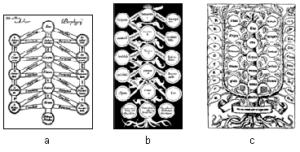 Boëthius’s translation emerged as the standard textbook for teaching Aristotelian logic during the Middle Ages – even through to the late 19th century. During this time, Porphyry’s “scale of being” was eventually illustrated by unknown artists into different types of trees. These illustrations (pictured right) are known as the Porphyrian Trees. In 1745, Swiss naturalist Charles Bonnet is credited as publishing a diagram – although, not a tree – Illustrating an organized sequence of nature that was known as the “Great chain of being.” This diagram demonstrates how Aristotle’s philosophical principles of evolution had already been incorporated into western academic circles more than a century before The Origin of Species was first published in 1859.
Boëthius’s translation emerged as the standard textbook for teaching Aristotelian logic during the Middle Ages – even through to the late 19th century. During this time, Porphyry’s “scale of being” was eventually illustrated by unknown artists into different types of trees. These illustrations (pictured right) are known as the Porphyrian Trees. In 1745, Swiss naturalist Charles Bonnet is credited as publishing a diagram – although, not a tree – Illustrating an organized sequence of nature that was known as the “Great chain of being.” This diagram demonstrates how Aristotle’s philosophical principles of evolution had already been incorporated into western academic circles more than a century before The Origin of Species was first published in 1859.
Pre-Darwin “Tree of Life” Logic
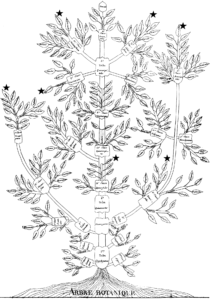 The earliest known biological “tree of life” illustration was of the plant kingdom published by Augustin Augier, a French botanist, in 1801. As a “figure like a genealogical tree,” Augier argued, “appears to be the most proper to grasp the order and gradation” of life. To Aristotle’s what and why logic approach, Augier argued –
The earliest known biological “tree of life” illustration was of the plant kingdom published by Augustin Augier, a French botanist, in 1801. As a “figure like a genealogical tree,” Augier argued, “appears to be the most proper to grasp the order and gradation” of life. To Aristotle’s what and why logic approach, Augier argued –
“It appears, and one can hardly doubt it, that the Creator, when making flowers, followed certain proportions and progressions in the number of their different parts.”
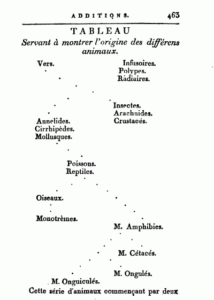 Within ten years, Jean-Baptiste Lamarck, a French zoologist, published the first branching tree of animals (pictured right) in his Philosophie Zoologique in 1809. Unlike contemporary colleagues, including Darwin, since Lamarck did not believe in common ancestry, his graphic illustration did not include a trunk. American geologist Edward Hitchcock published his first tree of life in 1840. The book, entitled Elementary Geology, was based on what he knew about fossils along with his geological observations.
Within ten years, Jean-Baptiste Lamarck, a French zoologist, published the first branching tree of animals (pictured right) in his Philosophie Zoologique in 1809. Unlike contemporary colleagues, including Darwin, since Lamarck did not believe in common ancestry, his graphic illustration did not include a trunk. American geologist Edward Hitchcock published his first tree of life in 1840. The book, entitled Elementary Geology, was based on what he knew about fossils along with his geological observations. 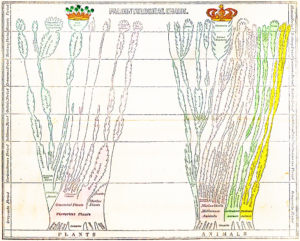 In the editions published between 1840 and 1859, his “paleontological chart” included two trees (pictured left); one for plants and the other for animals. As a leading advocate of the gap theory, Hitchcock argued –
In the editions published between 1840 and 1859, his “paleontological chart” included two trees (pictured left); one for plants and the other for animals. As a leading advocate of the gap theory, Hitchcock argued –
“The gradual introduction of ‘higher races’ is perfectly explained by the changing condition of the earth which is being adapted for more perfect races Divine Wisdom introduced them.”
Ironically, even though Hitchcock advanced a “higher races” theory and Darwin argued for the “preservation of favoured races,” Hitchcock opposed applying Darwin’s theory of natural selection to humans. Hitchcock was a Congregational pastor and professor of chemistry and natural history at Amherst College, Massachusetts. Subsequent editions of Elementary Geology were published without his once popular “paleontological chart.” 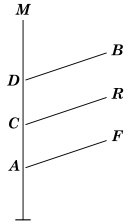 In 1844, Robert Chambers, a Scottish journalist, anonymously published an international best seller entitled the Vestiges of the Natural History of Creation. The book was wildly popular with contemporary radicals, yet, even Prince Albert is reported to have read it to Queen Victoria. The book included a diagram (pictured right) indicating how the evolutionary path of fish, reptiles and birds ascended to the formation of mammals. By 1859, evolution was as controversial then as politics are today. In the words of Darwin, “evolution was in the air” as the book sales demonstrated. All 1,250 copies of the book released by the publisher were sold on the first day – a publisher’s dream.
In 1844, Robert Chambers, a Scottish journalist, anonymously published an international best seller entitled the Vestiges of the Natural History of Creation. The book was wildly popular with contemporary radicals, yet, even Prince Albert is reported to have read it to Queen Victoria. The book included a diagram (pictured right) indicating how the evolutionary path of fish, reptiles and birds ascended to the formation of mammals. By 1859, evolution was as controversial then as politics are today. In the words of Darwin, “evolution was in the air” as the book sales demonstrated. All 1,250 copies of the book released by the publisher were sold on the first day – a publisher’s dream.
Darwin’s Perfect Timing
 “It was just enough, in the right form, at the right time,” said Quammen. “It presented the theory as ‘one long argument,’ not with a bare syllogism, and with oodles of data but many footnotes. It was plain spoken, and readable by any literate person.”
“It was just enough, in the right form, at the right time,” said Quammen. “It presented the theory as ‘one long argument,’ not with a bare syllogism, and with oodles of data but many footnotes. It was plain spoken, and readable by any literate person.”
“The affinities of all the beings of the same class,” Darwin had argued, “have sometimes been represented by a great tree… all animals of [the] same species are bound together just like buds of plants.”
The Origin of Species gained immediate global recognition. In Darwin’s lifetime, the book was translated into Danish, Dutch, French, German, Hungarian, Italian, Polish, Russian, Serbian, Spanish, and Swedish. When goodreads, a literary group managed by Amazon, asked members to rate “the most influential books in history,” Darwin’s Origin of Species was rated second only to the King James version of the bible. The theory gained notoriety, but only as a scientifically untested theory. Not until the biotechnological advances developed in the 20th and early 21st century have scientists had the tools to validate Darwin’s “one long argument” theory.
Molecular Biology Revolution
Biomolecular technologies developed during the 20th century unleashed a revolution in molecular biology. Laboratory equipment, instruments, computer hardware and software, once unimaginable in the 19th century, revolutionized the scientific approach to validate the theory of evolution. Scientists, since the publication of The Origin of Species, had been searching for the type of evidence that could be tested and re-tested to scientifically validate the theory. Molecular biology is exactly that type of evidence.  In 1953 while working at the Cavendish Laboratory at the University of Cambridge, Francis Crick, a British molecular biologist using x-ray technology, co-authored the paper proposing that the molecular structure of inheritance was a double helix structure (pictured right). Subsequent testing quickly validated that the DNA molecule was a double helix structure – as predicted from their objective evidence. For the finding, Crick was jointly awarded the Nobel Prize in 1962. Amazingly, Darwin’s long-standing unsolved mystery – inheritable variations – was finally solved at his alma mater; Cambridge University.
In 1953 while working at the Cavendish Laboratory at the University of Cambridge, Francis Crick, a British molecular biologist using x-ray technology, co-authored the paper proposing that the molecular structure of inheritance was a double helix structure (pictured right). Subsequent testing quickly validated that the DNA molecule was a double helix structure – as predicted from their objective evidence. For the finding, Crick was jointly awarded the Nobel Prize in 1962. Amazingly, Darwin’s long-standing unsolved mystery – inheritable variations – was finally solved at his alma mater; Cambridge University.  In 1957, Crick (pictured with James Watson left) presented at the Society for Experimental Biology symposium a revolutionary vision finally linking molecular biology to the secrets driving evolution. Crick explained –
In 1957, Crick (pictured with James Watson left) presented at the Society for Experimental Biology symposium a revolutionary vision finally linking molecular biology to the secrets driving evolution. Crick explained –
“Biologists should realize that before long we shall have a subject which might be called ‘protein taxonomy’ – the study of amino acids sequences of the proteins of an organism [products of DNA and RNA] and the comparison between species … The vast amount of evolutionary history may be hidden away within them.”
Linking changes in molecular biology to genetic inheritance is now argued as the primary mechanism driving evolution. Discoveries in the field of molecular biology were anticipated to reveal and retrace the mysterious steps of evolution molecule-by-molecule.  The bet was on. Questions regarding the scientific validity of evolution were anticipated to be finally solved. Giuseppe Sermonti, an Italian geneticist said –
The bet was on. Questions regarding the scientific validity of evolution were anticipated to be finally solved. Giuseppe Sermonti, an Italian geneticist said –
“It seemed as though life could be disassembled and reassembled like a child’s blocks.”
At a subsequent 1964 symposium at Rutgers University, Emile Zuckerkandl along with Francis Crick and Linus Pauling, argued that
“the branching of molecular phylogenetic trees should in principle be definable in terms of molecular information alone.”
Laboratories in the subsequent decades produced unprecedented scientific breakthroughs. With the accuracy and speed of testing dramatically improving, the rate of new scientific breakthroughs gave rise to the Genomic Revolution. By the turn of the century, the FDA had approved the safe and effective use of more than 125 genetically engineered drugs in healthcare. Use of these technologies emerged as a standard of practice in biological science laboratories – and in the laboratories dedicated to studying the theory of evolution. As Quammen noted,
“This was a whole new way of sketching those trees which rose and spread their branches as the clock ticked.”
Revolutionary Outcome
Towards the end of the 21st century’s first decade, scientists began to evaluate the newly emerging biomolecular data from the fossil record to review the potential implications. Molecular biology was expected to overcome the theories long-lasting scientific issues.  Stephen Jay Gould (pictured left), an evolution paleontologist at Harvard University and a long-time critic of Darwin’s tree, wrote –
Stephen Jay Gould (pictured left), an evolution paleontologist at Harvard University and a long-time critic of Darwin’s tree, wrote –
“The evolutionary trees that adorn our textbooks have data only at the tips and nodes of their branches; the rest is inference, however reasonable, not the evidence of fossils.”
By the end of the first decade, since integrating the emerging molecular evidence into the standard theory [known as Neo-Darwinism or Modern Synthesis] was becoming increasingly problematic, The Royal Society invited internationally recognized evolution scientists to a 3-day meeting in November 2016, stating –
“Developments in evolutionary biology and adjacent fields have produced calls for revision of the standard theory of evolution, although the issues involved remain hotly contested.”
 At the conclusion of the contentious meeting, the attendees could not develop a consensus on any revisions. Huffington Post journalist, Suzan Mazur (pictured right), asked –
At the conclusion of the contentious meeting, the attendees could not develop a consensus on any revisions. Huffington Post journalist, Suzan Mazur (pictured right), asked –
“Why is it so difficult to pull together the most compelling ideas in evolutionary biology and come up with an approximate understanding of how it all works?”
 Eugene Koonin (pictured left), head of the Evolutionary Genomics Group, National Center for Biotechnology Information, National Institute of Health, noted –
Eugene Koonin (pictured left), head of the Evolutionary Genomics Group, National Center for Biotechnology Information, National Institute of Health, noted –
“The public is already extremely skeptical about the value and the scientific nature of evolutionary biology… The genomic revolution… effectively overturned the central metaphor of evolutionary biology, the Tree of Life.”
 After 150 years, evolution theorists seem to have exhausted conceivable natural mechanisms. Lynn Margulis (pictured right), evolution theorist awarded the National Medal of Science Award, and a long critic of Darwin’s tree, pointed out the problem –
After 150 years, evolution theorists seem to have exhausted conceivable natural mechanisms. Lynn Margulis (pictured right), evolution theorist awarded the National Medal of Science Award, and a long critic of Darwin’s tree, pointed out the problem –
“The notion is that if we accumulate enough gene change, enough genetic mutations, we explain the passage from one species to another. This is depicted as two branches in a family tree that emerge from one common ancestor to the two descendants. An entire Anglophone academic tradition of purported evolutionary description was developed quantified, computerized based on what I think is a conceptual topological error.”
 “The tree of life is an artifact of some early scientific studies that aren’t really holding up… So there is not a tree of life,” noted Craig Venter (pictured left), an American biotechnologist, biochemist, geneticist, and businessman known for leading the first draft sequence of the human genome. Italian geneticist Giuseppe Sermonti explains that a “genealogical tree that shows forms gradually varying and diverging—the ‘fact’ for which Darwinism proposed its revolutionary explanation—is nowhere to be found.” Not surprisingly –
“The tree of life is an artifact of some early scientific studies that aren’t really holding up… So there is not a tree of life,” noted Craig Venter (pictured left), an American biotechnologist, biochemist, geneticist, and businessman known for leading the first draft sequence of the human genome. Italian geneticist Giuseppe Sermonti explains that a “genealogical tree that shows forms gradually varying and diverging—the ‘fact’ for which Darwinism proposed its revolutionary explanation—is nowhere to be found.” Not surprisingly –
“Science has taken on the great wager… and lost.”
Darwin’s dilemma intensifies.
Genesis
Beginning in Genesis, the “tree of life” phrase has signified new beginnings prospering in peace and harmony throughout the centuries of human history. The beginning of all that is good originates from the Bible. In using the “tree of life” phrase far removed from it’s original purpose, Darwin’s tree got tangled – and lost. That’s what happened.
Advanced technologies, while continuing to undermine the theory of evolution, continues to generate scientific evidence that is increasingly compatible with the Genesis record written by Moses.  Nicholas Copernicus (1473-1543), a Renaissance mathematician and astronomer, proposed that Earth rotates around the Sun. The theory, known as a heliocentric theory eventually upended the once accepted geocentric model of our solar system commented on our Creator during the Scientific Revolution –
Nicholas Copernicus (1473-1543), a Renaissance mathematician and astronomer, proposed that Earth rotates around the Sun. The theory, known as a heliocentric theory eventually upended the once accepted geocentric model of our solar system commented on our Creator during the Scientific Revolution –
“To know the mighty works of God, to comprehend His wisdom and majesty and power; to appreciate, in degree, the wonderful workings of His laws, surely all this must be a pleasing and acceptable mode of worship to the Most High, to whom ignorance cannot be more grateful than knowledge.”
Biological evolution exists only as a philosophy; not as a scientific fact.
Refer to the Glossary for the definition of terms and to Understanding Evolution to gain insights into understanding evolution.


